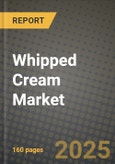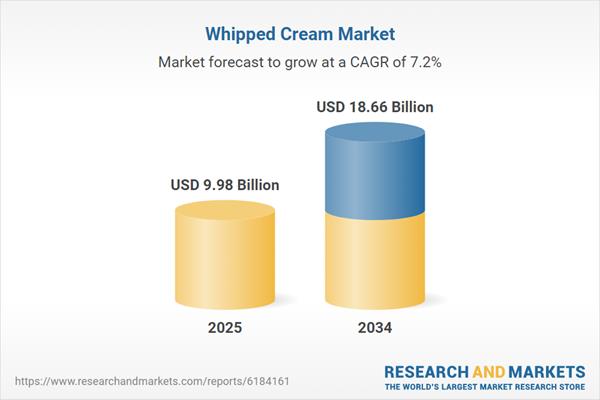Whipped Cream Market
The Whipped Cream Market encompasses dairy-based and plant-based whipped toppings produced through pressurized aerosol cans, frozen and chilled tubs, UHT cartons, and spray-ready bakery formats used across desserts, beverages, bakery fillings, confectionery, and foodservice. Demand is buoyed by café culture expansion, indulgent home desserts, ready-to-eat bakery growth, and social media-driven visual appeal, alongside reformulation toward longer shelf life, cleaner labels, and plant-based alternatives. Dairy whipped cream retains dominance owing to superior mouthfeel and aeration, yet growth accelerates in vegan lines leveraging coconut, soy, oat, or almond bases with emulsifier and stabilizer systems tuned for whipping performance and heat tolerance. Technological innovation focuses on gas stability (N₂O/CO₂ blends), controlled overrun, anti-syneresis systems, and aseptic packaging that maintains foam integrity and microbial safety. Flavor extensions (vanilla, caramel, chocolate, seasonal pumpkin spice), sugar-reduced variants, and color-stable toppings expand versatility in both retail and café channels. Headwinds include price volatility in dairy fat, scrutiny of nitrous oxide as a greenhouse gas, and the balancing act between indulgence and health messaging. Distribution evolves omnichannel: hypermarkets, refrigerated supply to quick-service restaurants, and ambient UHT lines for e-commerce. Regulatory compliance around aerosol propellants, labeling (vegan vs. dairy), and food safety traceability are rising priorities. As convenience and aesthetics converge, winning brands combine stable foam structure, indulgent texture, extended shelf life, and sustainability - from recyclable cans to low-emission gases - positioning whipped cream as both a functional and experiential indulgence across global bakery, beverage, and dessert ecosystems.Whipped Cream Market Key Insights
- Premium indulgence meets everyday convenience
- Plant-based formulations drive incremental growth
- Stability and overrun control are key differentiators
- Regulatory and sustainability pressures reshape propellant use
- Sugar reduction and flavored innovation broaden appeal
- Foodservice modernization drives bulk demand
- Cold-chain efficiency and aseptic breakthroughs extend reach
- Digital and experiential marketing lift premium perception
- Plant-protein integration improves nutritional profile
- Circularity and packaging innovation attract eco-aware buyers
Whipped Cream Market Reginal Analysis
North America
High consumption of dairy desserts, café beverages, and home baking sustains a mature yet premiumizing market. Growth in plant-based and sugar-reduced variants is strong; aerosol and frozen segments dominate retail. Sustainability in propellant gas and recyclable packaging is a key differentiation, while foodservice channels rely on bulk bag-in-box systems for consistency and labor efficiency.Europe
Stringent clean-label standards and environmental regulations drive innovation in low-emission propellants, organic dairy sourcing, and vegan formulations. Western Europe leads in flavor experimentation and whipped cream desserts, while Eastern Europe prioritizes affordability. Retailers emphasize private-label offerings aligned with traceable dairy and eco-friendly cans.Asia-Pacific
Rapid café proliferation, westernized desserts, and e-commerce expansion propel strong growth. UHT whipping cream and non-dairy aerosol formats gain traction due to hot climates and storage limitations. Local producers invest in coconut and oat-based options suited for lactose-intolerant consumers. Branding around café-style experience fuels adoption among youth demographics.Middle East & Africa
Hospitality, tourism, and premium bakery chains anchor demand; halal-certified dairy and clean-label vegan alternatives rise in importance. Heat stability and shelf-life resilience define procurement specs. Import reliance persists, but local dairy processors expand with UHT and spray-can lines for hotels and QSRs.South & Central America
Growing confectionery, bakery, and beverage industries support consistent demand, with affordability and ambient-stable packaging key to growth. Dairy volatility encourages partial substitution with vegetable-fat blends. Distribution through supermarkets and emerging cafés broadens reach, while private labels emphasize accessible indulgence and long shelf life.Whipped Cream Market Segmentation
By Type
- Condensed Milk
- Evaporated Milk
By Distribution Channel
- Warehouse Clubs
- Convenience Stores
- Specialist Retailers
- Supermarkets/Hypermarkets
- Online
- Variety Stores
- Department Stores
- Others
Key Market players
Lactalis, Nestlé, FrieslandCampina, Fonterra, Arla Foods, Savencia (Elle & Vire), Rich Products Corporation, Conagra Brands (Reddi-wip), Saputo, Emmi Group, Meggle, DMK Group, Amul (GCMMF), Yili Group, China Mengniu Dairy, Morinaga Milk Industry, Megmilk Snow Brand, Unigrà (Master Martini/Hulalà), Puratos, DanoneWhipped Cream Market Analytics
The report employs rigorous tools, including Porter’s Five Forces, value chain mapping, and scenario-based modelling, to assess supply-demand dynamics. Cross-sector influences from parent, derived, and substitute markets are evaluated to identify risks and opportunities. Trade and pricing analytics provide an up-to-date view of international flows, including leading exporters, importers, and regional price trends.Macroeconomic indicators, policy frameworks such as carbon pricing and energy security strategies, and evolving consumer behaviour are considered in forecasting scenarios. Recent deal flows, partnerships, and technology innovations are incorporated to assess their impact on future market performance.
Whipped Cream Market Competitive Intelligence
The competitive landscape is mapped through proprietary frameworks, profiling leading companies with details on business models, product portfolios, financial performance, and strategic initiatives. Key developments such as mergers & acquisitions, technology collaborations, investment inflows, and regional expansions are analyzed for their competitive impact. The report also identifies emerging players and innovative startups contributing to market disruption.Regional insights highlight the most promising investment destinations, regulatory landscapes, and evolving partnerships across energy and industrial corridors.
Countries Covered
- North America - Whipped Cream market data and outlook to 2034
- United States
- Canada
- Mexico
- Europe - Whipped Cream market data and outlook to 2034
- Germany
- United Kingdom
- France
- Italy
- Spain
- BeNeLux
- Russia
- Sweden
- Asia-Pacific - Whipped Cream market data and outlook to 2034
- China
- Japan
- India
- South Korea
- Australia
- Indonesia
- Malaysia
- Vietnam
- Middle East and Africa - Whipped Cream market data and outlook to 2034
- Saudi Arabia
- South Africa
- Iran
- UAE
- Egypt
- South and Central America - Whipped Cream market data and outlook to 2034
- Brazil
- Argentina
- Chile
- Peru
Research Methodology
This study combines primary inputs from industry experts across the Whipped Cream value chain with secondary data from associations, government publications, trade databases, and company disclosures. Proprietary modeling techniques, including data triangulation, statistical correlation, and scenario planning, are applied to deliver reliable market sizing and forecasting.Key Questions Addressed
- What is the current and forecast market size of the Whipped Cream industry at global, regional, and country levels?
- Which types, applications, and technologies present the highest growth potential?
- How are supply chains adapting to geopolitical and economic shocks?
- What role do policy frameworks, trade flows, and sustainability targets play in shaping demand?
- Who are the leading players, and how are their strategies evolving in the face of global uncertainty?
- Which regional “hotspots” and customer segments will outpace the market, and what go-to-market and partnership models best support entry and expansion?
- Where are the most investable opportunities - across technology roadmaps, sustainability-linked innovation, and M&A - and what is the best segment to invest over the next 3-5 years?
Your Key Takeaways from the Whipped Cream Market Report
- Global Whipped Cream market size and growth projections (CAGR), 2024-2034
- Impact of Russia-Ukraine, Israel-Palestine, and Hamas conflicts on Whipped Cream trade, costs, and supply chains
- Whipped Cream market size, share, and outlook across 5 regions and 27 countries, 2023-2034
- Whipped Cream market size, CAGR, and market share of key products, applications, and end-user verticals, 2023-2034
- Short- and long-term Whipped Cream market trends, drivers, restraints, and opportunities
- Porter’s Five Forces analysis, technological developments, and Whipped Cream supply chain analysis
- Whipped Cream trade analysis, Whipped Cream market price analysis, and Whipped Cream supply/demand dynamics
- Profiles of 5 leading companies - overview, key strategies, financials, and products
- Latest Whipped Cream market news and developments
Additional Support
With the purchase of this report, you will receive:- An updated PDF report and an MS Excel data workbook containing all market tables and figures for easy analysis.
- 7-day post-sale analyst support for clarifications and in-scope supplementary data, ensuring the deliverable aligns precisely with your requirements.
- Complimentary report update to incorporate the latest available data and the impact of recent market developments.
This product will be delivered within 1-3 business days.
Table of Contents
Companies Mentioned
- Lactalis
- Nestlé
- FrieslandCampina
- Fonterra
- Arla Foods
- Savencia (Elle & Vire)
- Rich Products Corporation
- Conagra Brands (Reddi-wip)
- Saputo
- Emmi Group
- Meggle
- DMK Group
- Amul (GCMMF)
- Yili Group
- China Mengniu Dairy
- Morinaga Milk Industry
- Megmilk Snow Brand
- Unigrà (Master Martini/Hulalà)
- Puratos
- Danone
Table Information
| Report Attribute | Details |
|---|---|
| No. of Pages | 160 |
| Published | November 2025 |
| Forecast Period | 2025 - 2034 |
| Estimated Market Value ( USD | $ 9.98 Billion |
| Forecasted Market Value ( USD | $ 18.66 Billion |
| Compound Annual Growth Rate | 7.2% |
| Regions Covered | Global |
| No. of Companies Mentioned | 20 |









